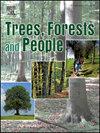Influence of bark beetle infestation on stem diameter dynamics
IF 2.7
Q1 FORESTRY
引用次数: 0
Abstract
Bark beetle epidemics have increased globally due to drought and a warming climate, impairing forest ecosystem services by inducing severe forest disturbances. Bark beetle infestation monitoring is urgently needed for pre-emptive forest management. However, we have a lack of thorough understanding of the physiological responses that occur on trees after a bark beetle infestation. More specifically, we need insights into how quickly trees decline post-infestation and how the rate of tree decline relates to the bark beetle brood development. To increase understanding of trees’ physiological responses to bark beetle infestation, we monitored stem diameter variations at 15-minute intervals across 31 healthy and 26 infested mature Norway spruces affected by the European spruce bark beetle (Ips typographus L.) in Southern Finland. We observed that the infestation led to reduced or negligible growth, followed by a sudden decline in stem diameter. Using dendrometer data, we also established a point of ceased stem expansion for trees affected by bark beetle infestation, serving as a proxy for the tree's physiological response. This allowed us to explore the duration between the infestation date and the onset of tree decline. We observed considerable temporal variation in the physiological response of trees to the bark beetle infestation. The timing of the point of ceased stem expansion ranged from 15 to 81 days after the onset of the simulated infestation date, with a mean of 46.8 days. Only 58 % of the trees showed a point of ceased stem expansion before the bark beetle brood development was completed. This suggests that trees may take longer to respond to the infestation than it takes for the bark beetle brood to develop. Considerable temporal variation in tree response to the bark beetle infestation was observed, which calls for more research to understand the temporal dynamics of the tree's response to bark beetle infestations.
树皮甲虫侵染对茎粗动态的影响
由于干旱和气候变暖,树皮甲虫流行病在全球范围内增加,引起严重的森林干扰,损害了森林生态系统服务。树皮甲虫侵害监测是森林先发制人管理的迫切需要。然而,我们对树皮甲虫侵染后树木的生理反应缺乏透彻的了解。更具体地说,我们需要了解树木在感染后衰退的速度,以及树木衰退的速度与树皮甲虫幼虫发育的关系。为了进一步了解树木对树皮甲虫侵染的生理反应,我们在芬兰南部监测了31棵健康的挪威云杉和26棵受欧洲云杉树皮甲虫(Ips typographus L.)侵染的成熟挪威云杉的茎直径变化,每隔15分钟监测一次。我们观察到,侵染导致生长减少或可以忽略不计,随后茎粗突然下降。利用树径计数据,我们还建立了受树皮甲虫侵害的树木的茎停止扩张点,作为树木生理反应的代理。这使我们能够探索侵染日期和树木开始衰退之间的持续时间。我们观察到树木对树皮甲虫侵染的生理反应有相当大的时间变化。在模拟侵染日开始后15 ~ 81天,树干停止扩张的时间为46.8天。在树皮甲虫幼虫发育完成之前,只有58%的树木显示出茎部停止扩张的点。这表明树木对虫害的反应可能比树皮甲虫孵化所需的时间要长。观察到树木对树皮甲虫侵染的反应有相当大的时间变化,这需要更多的研究来了解树木对树皮甲虫侵染的反应的时间动态。
本文章由计算机程序翻译,如有差异,请以英文原文为准。
求助全文
约1分钟内获得全文
求助全文
来源期刊

Trees, Forests and People
Economics, Econometrics and Finance-Economics, Econometrics and Finance (miscellaneous)
CiteScore
4.30
自引率
7.40%
发文量
172
审稿时长
56 days
 求助内容:
求助内容: 应助结果提醒方式:
应助结果提醒方式:


